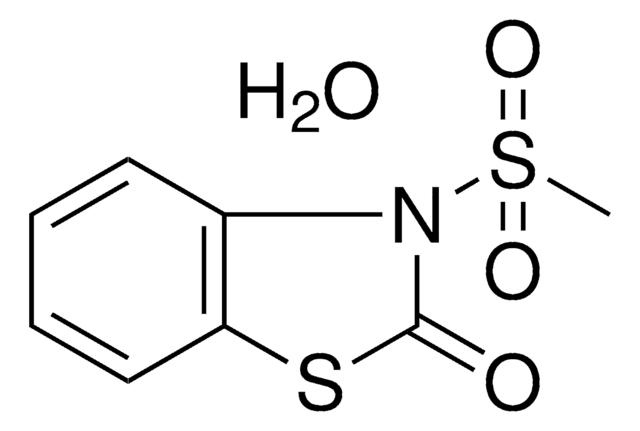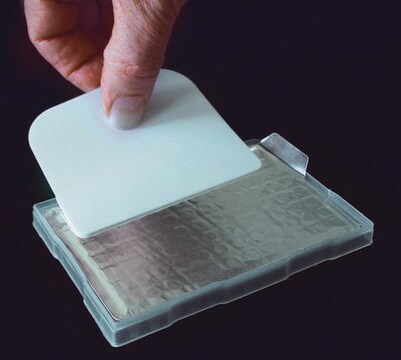NS1226
Cysteine Sulfenic Acid Probe (DCP-Bio1)
Faça loginpara ver os preços organizacionais e de contrato
About This Item
Código UNSPSC:
12352200
eCl@ss:
32160405
NACRES:
NA.25
Produtos recomendados
Nível de qualidade
Descrição geral
Cysteine residues in certain proteins can be oxidized transiently to cysteine sulfenic acid, and such oxidation events may affect enzymatic activity and thus regulate signaling pathways. Most proteins containing cysteine sulfenic acid only do so when the cell contains elevated levels of reactive oxygen species although some proteins, such as GAPDH, appear to contain cysteine sulfenic acid under ordinary conditions.
The most commonly used method for assessing whether proteins are modified to contain cysteine sulfenic acid employs derivitization with 5,5-dimethyl-1,3-cyclohexanedione (dimedone), and subsequent detection with an antibody against dimedone-modified proteins. However, new reagents have been developed to simplify the analysis and isolation of proteins bearing cysteine sulfenic acid. DCP-Bio1, which consists of the sulfenic acid-reactive 3-(2,4-dioxocyclohexyl) propyl (DCP) appended to biotin, is a useful reagent for characterizing cellular cysteine sulfenic acid.
The most commonly used method for assessing whether proteins are modified to contain cysteine sulfenic acid employs derivitization with 5,5-dimethyl-1,3-cyclohexanedione (dimedone), and subsequent detection with an antibody against dimedone-modified proteins. However, new reagents have been developed to simplify the analysis and isolation of proteins bearing cysteine sulfenic acid. DCP-Bio1, which consists of the sulfenic acid-reactive 3-(2,4-dioxocyclohexyl) propyl (DCP) appended to biotin, is a useful reagent for characterizing cellular cysteine sulfenic acid.
Aplicação
PROTOCOL
Solutions:
DCP-Bio1 stock solution
Resuspend entire contents of vial in 10 µL DMSO for a final concentration of 250 mM
Stock lysis buffer
50 mM Tris-HCl, pH 7.5
100 mM Sodium Chloride
0.1% SDS
0.5% Sodium Deoxycholate
0.5% NP-40
0.5% Triton X-100
Working lysis buffer
On the day of the assay, supplement stock lysis buffer with:
50 mM Sodium Fluoride
1 mM PMSF
1 mM DCP-Bio1
100 µM DTPA (Diethylene triamine pentaacetic acid)
10 mM N-ethylmaleimide
10 mM iodoacetamide
200 U/mL catalase
1x protease inhibitor cocktail
Cell treatment and lysis:
1)Seed adherent cells in 100 mm cell culture dishes, or other plate as desired.
2)Change to fresh growth media 30 minutes before selected treatments.
3)Wash all plates 2 times with 10 mL 1x PBS.
4)Add 150 µL working lysis buffer to plates and scrape cells.
5)Incubate lysates on ice for 1-2 hours.
6)Centrifuge lysates at 10,000 rpm for 10 minutes and collect supernatant.
7)Remove un-reacted DCP-Bio1 and other small molecules using Bio-Rad P6-Spin Columns (PN: 732-6227) following manufacturer′s instructions.
8)Measure protein concentration.
9)Perform biochemical analysis of interest.
Solutions:
DCP-Bio1 stock solution
Resuspend entire contents of vial in 10 µL DMSO for a final concentration of 250 mM
Stock lysis buffer
50 mM Tris-HCl, pH 7.5
100 mM Sodium Chloride
0.1% SDS
0.5% Sodium Deoxycholate
0.5% NP-40
0.5% Triton X-100
Working lysis buffer
On the day of the assay, supplement stock lysis buffer with:
50 mM Sodium Fluoride
1 mM PMSF
1 mM DCP-Bio1
100 µM DTPA (Diethylene triamine pentaacetic acid)
10 mM N-ethylmaleimide
10 mM iodoacetamide
200 U/mL catalase
1x protease inhibitor cocktail
Cell treatment and lysis:
1)Seed adherent cells in 100 mm cell culture dishes, or other plate as desired.
2)Change to fresh growth media 30 minutes before selected treatments.
3)Wash all plates 2 times with 10 mL 1x PBS.
4)Add 150 µL working lysis buffer to plates and scrape cells.
5)Incubate lysates on ice for 1-2 hours.
6)Centrifuge lysates at 10,000 rpm for 10 minutes and collect supernatant.
7)Remove un-reacted DCP-Bio1 and other small molecules using Bio-Rad P6-Spin Columns (PN: 732-6227) following manufacturer′s instructions.
8)Measure protein concentration.
9)Perform biochemical analysis of interest.
Solutions:
DCP-Bio1 stock solution
Resuspend entire contents of vial in 10 µL DMSO for a final concentration of 250 mM
Stock lysis buffer
50 mM Tris-HCl, pH 7.5
100 mM Sodium Chloride
0.1% SDS
0.5% Sodium Deoxycholate
0.5% NP-40
0.5% Triton X-100
Working lysis buffer
On the day of the assay, supplement stock lysis buffer with:
50 mM Sodium Fluoride
1 mM PMSF
1 mM DCP-Bio1
100 µM DTPA (Diethylene triamine pentaacetic acid)
10 mM N-ethylmaleimide
10 mM iodoacetamide
200 U/mL catalase
1x protease inhibitor cocktail
Cell treatment and lysis:
1)Seed adherent cells in 100 mm cell culture dishes, or other plate as desired.
2)Change to fresh growth media 30 minutes before selected treatments.
3)Wash all plates 2 times with 10 mL 1x PBS.
4)Add 150 µL working lysis buffer to plates and scrape cells.
5)Incubate lysates on ice for 1-2 hours.
6)Centrifuge lysates at 10,000 rpm for 10 minutes and collect supernatant.
7)Remove un-reacted DCP-Bio1 and other small molecules using Bio-Rad P6-Spin Columns (PN: 732-6227) following manufacturer′s instructions.
8)Measure protein concentration.
9)Perform biochemical analysis of interest.
DCP-Bio1 stock solution
Resuspend entire contents of vial in 10 µL DMSO for a final concentration of 250 mM
Stock lysis buffer
50 mM Tris-HCl, pH 7.5
100 mM Sodium Chloride
0.1% SDS
0.5% Sodium Deoxycholate
0.5% NP-40
0.5% Triton X-100
Working lysis buffer
On the day of the assay, supplement stock lysis buffer with:
50 mM Sodium Fluoride
1 mM PMSF
1 mM DCP-Bio1
100 µM DTPA (Diethylene triamine pentaacetic acid)
10 mM N-ethylmaleimide
10 mM iodoacetamide
200 U/mL catalase
1x protease inhibitor cocktail
Cell treatment and lysis:
1)Seed adherent cells in 100 mm cell culture dishes, or other plate as desired.
2)Change to fresh growth media 30 minutes before selected treatments.
3)Wash all plates 2 times with 10 mL 1x PBS.
4)Add 150 µL working lysis buffer to plates and scrape cells.
5)Incubate lysates on ice for 1-2 hours.
6)Centrifuge lysates at 10,000 rpm for 10 minutes and collect supernatant.
7)Remove un-reacted DCP-Bio1 and other small molecules using Bio-Rad P6-Spin Columns (PN: 732-6227) following manufacturer′s instructions.
8)Measure protein concentration.
9)Perform biochemical analysis of interest.
Componentes
DCP-Bio1 (Part No. CS211419): 1 mg dry powder, stored under argon.
Qualidade
DCP-Bio1 Purity: ≥ 90% pure as determined by 1H NMR. DCP-Bio1 Solubility: Freely soluble in DMSO DCP-Bio1 Mw: 396.5
Armazenamento e estabilidade
The product can be stored at -20°C. The dry powder, if unopened and stored properly, is usable for at least 4 months from date of receipt. Once resuspended the DCP-Bio-1 solution should be stored in the dark at -20°C. TOXICITY: Although the compound appears to be of low toxicity, it has not been extensively evaluated and therefore routine laboratory caution should be exercised. Not intended for human consumption. Important Note: During shipment, small amounts of product will occasionally become entrapped in the seal of the product vial. For products with masses of 5 mg or less, we recommend gently tapping the vial on a hard surface or briefly centrifuging the vial in a tabletop centrifuge to dislodge any powder in the container′s cap.
Exoneração de responsabilidade
Unless otherwise stated in our catalog or other company documentation accompanying the product(s), our products are intended for research use only and are not to be used for any other purpose, which includes but is not limited to, unauthorized commercial uses, in vitro diagnostic uses, ex vivo or in vivo therapeutic uses or any type of consumption or application to humans or animals.
Código de classe de armazenamento
11 - Combustible Solids
Classe de risco de água (WGK)
WGK 3
Ponto de fulgor (°F)
Not applicable
Ponto de fulgor (°C)
Not applicable
Certificados de análise (COA)
Busque Certificados de análise (COA) digitando o Número do Lote do produto. Os números de lote e remessa podem ser encontrados no rótulo de um produto após a palavra “Lot” ou “Batch”.
Já possui este produto?
Encontre a documentação dos produtos que você adquiriu recentemente na biblioteca de documentos.
Nossa equipe de cientistas tem experiência em todas as áreas de pesquisa, incluindo Life Sciences, ciência de materiais, síntese química, cromatografia, química analítica e muitas outras.
Entre em contato com a assistência técnica





